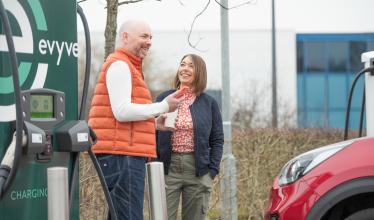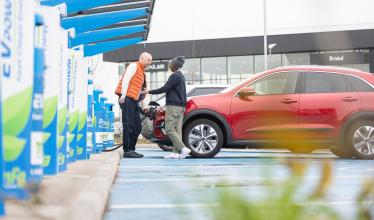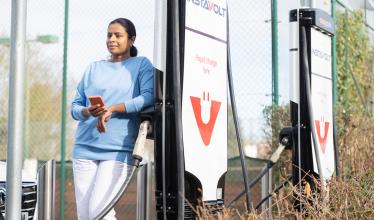If you’re thinking about buying an electric car, but are having reservations about making the switch, perhaps because of concerns over range, then keep reading. Zap-Map recently spoke to electric vehicle (EV) driver Paul Amess about a remarkably cheap electric road trip he completed with a friend earlier this year.
Here he tells us about why he loves driving an electric car, explains what motivated him to start his mammoth electric road trip, and shares his advice for anyone thinking about buying an electric car.
Step 1: Buying an electric car
Paul, who is from Hull, does not consider himself an early adopter of EVs. However, in 2016 he bought an ageing, first-generation Nissan Leaf.
“My wife and I wanted to clean up our lives and reduce our carbon footprint,” he says. “I used to have an electric motorbike and, once I’d bought an electric vehicle, I never looked back. ICE cars just weren’t an option.”
He loved the Leaf, which to begin with he used for shorter journeys close to home. At the time, there were only a few charging points in Hull, although this did little to detract from the joy of the Leaf and how Paul was using it at the time.
“It’s so stress-free driving an electric car. It feels smooth, there’s a complete lack of vibration, no smell of petrol or diesel. Moving to automatic was a game changer as well,” says Paul. “Also, when you’re stuck behind a tractor, you’re not bothered because you’re saving charge.”
Then, in 2018, Paul downloaded Zap-Map and began using destination chargers further afield.
Step 2: Planning an electric road trip
Fast-forward to July 2021 and Paul, like countless others up and down the country, is feeling restless after three national lockdowns.
“My friend and I wanted to walk the Watershed, but realised it would take far too long, so we decided to drive it instead,” he says. “We basically wanted a post-lockdown adventure.”
But itchy feet weren’t the only motivation for the road trip. “I was in the market for a new electric car, so I wanted the Leaf to go out in style,” he continues. “I wanted to go on a road trip in it, just to see if this was viable at this still relatively early stage of the electric car revolution.”
Finally, there was also a community-based element to the trip, that many EV drivers are likely to be familiar with.
“I particularly wanted to discover any issues I would encounter along the way, such as ICE’d chargers, faulty equipment, software issues and anything else that came up really, so that I could share my experience with others,” says Paul. “So the trip was also partly inspired by and would have been impossible without Zap Map.”
Step 3: Driving an electric car to Portsmouth
In July 2021, after ‘Freedom Day’, Paul and a friend acting as his co-driver embarked on a week-long road trip in the old Nissan Leaf.
Now, it’s probably worth highlighting the range of the old Leaf that Paul and his friend Rob were driving. For comparison, the second-generation Nissan Leaf 40 kWh and the Nissan Leaf e+ now have real-world ranges of 160 miles and 230 miles respectively.
In contrast, Paul’s ageing first-generation model had a range of just over 60 miles in real terms. It was certainly an unusual electric car to choose to take on a road trip.
Before starting out, Paul and Rob used a combination of Ordnance Survey maps and Zap-Map’s route planner to plot their route from Hull down to Portsmouth. Their initial plan was to only use free charging devices, typically fast destination chargers at places like supermarkets.

The Ribblehead Viaduct, where Paul and Rob stopped off on their travels.
“Zap-Map was useful because it covered all networks and chargers – and we wouldn’t have done it without the route planner,” says Paul. “The live status on Zap-Map was also helpful, because the Leaf had a range of 60 miles.”
“If I can do a road trip in my old Leaf, you can do it in any electric car.”
In full knowledge of the challenge they had set themselves, Paul and Rob stuck to B-roads for their trip to keep the speed down, take in the scenery – and extend the Leaf’s range. When they stopped to charge the car, they spent their time exploring the sights of the towns they were driving through. For the most part, they charged at supermarkets and at local Nissan dealers, where staff were always helpful even if the charger didn’t always play ball.
Step 4: Overcoming range anxiety
Having reached Portsmouth, the next stage of the plan was to drive back up north, to the Scottish border, stopping off at interesting places along the way.
“It was a road trip I will never forget, that is for sure,” says Paul. “In total, we covered well over a thousand miles, which cost less than £25 – which is absolutely amazing. We used slower but free chargers much of the time, and while the car was charging, we would wander into whatever town we were in. We visited some incredible places, including the ancient capital of England, Winchester.”
Of course, in an old electric car with a range as low as Paul’s old Nissan Leaf, it wasn’t all plain sailing.
“It was great fun but also an eye-opener to the issues still facing EV drivers today, despite the slowly improving charging infrastructure that continues to take shape,” he continues. “I particularly remember turning up at one charger, desperate for a charge, only to find it blocked by a petrol car with a blue badge. When the old couple returned, I didn’t have the heart to say anything! Luckily, my five-metre charging cable just did the job, however.”

Paul and Rob’s route from Portsmouth to the Scottish border.
Although Paul and co-driver Rob encountered problems charging, they always managed to get a charge. When they arrived at Nissan dealerships, they sometimes had to wait, but were never turned away – unless, of course, the charging device was broken. One time, for instance, they rang ahead to a dealer in Loughborough to secure a charge in advance. When they got there, however, they found it had been out of order for two weeks. All was not lost, however, because they were able to find an alternative at a nearby pub, a paid-for rapid charger.
“Lots of people want an electric car, but are scared to take the leap. They don’t need to be.”
“Range anxiety is a real thing,” Paul adds here, “but one of the best things about the trip was that I was finally over whatever range anxiety I had before. It was great to learn about all the places we visited and their history. Near one of them, Highclere Castle, was the one and only time that we ran out of battery. We took a wrong turn and drove the wrong way down the M4. We got recharged from an RAC breakdown vehicle.”
Step 5: Sharing an electric experience
Some of the occasions when Paul and his co-driver came close to running out of charge were down to faulty devices. Some, like their experience near Highclere Castle, were down to human error. Others were simply down to a sense of adventure.
According to Paul, one of the first times this happened was after driving a section of the Woodhead Pass in the Peak District. Paul went down first. Of course, Rob then wanted another go, so they turned around and did it all over again. They then realised they were running low on battery. They found a charger on Zap-Map in the nearest town, and drove slowly towards it. Thankfully they made it, although Paul makes its sound like it was a close run thing.
Would they do it again? Definitely.

Thinking of buying an electric car? Why not follow in Paul’s footsteps and visit Winchester.
“England is such a beautiful country to drive through. You can do a road trip across this country in any direction,” says Paul. “Back when I got the Leaf, after I’d been to Rotherham and back I realised how low the cost was to charge it. Also, it’s just so reliable compared to an ICE car. This needs to be bigged up, I think,” he adds.
“That’s why I wanted to share our story. Because lots of people want an electric car, but are scared to take the leap. They don’t need to be.”
Does he have any advice for people buying an electric car?
“Just do it. You will not regret it. Once you’ve got an EV, you’ll never look back. Take a test drive. You will not be disappointed,” Paul says confidently. “Half the miles on my car have been from people test driving it.”
And what about for people who have just bought an electric car? “Get out there. Be adventurous. Go on a road trip. If I can do a road trip in my old Leaf, you can do it in any electric car,” he says.
“All in all, this was such an enjoyable trip. And it just goes to show what can be done, even with an old electric car.”
Paul’s next road trip is the North Coast 500, a 516-mile scenic route around the north coast of Scotland, starting and ending at Inverness Castle, which he will embark upon for 10 days this winter. He has also written a book, Electric Dreams Road Trip, detailing experiences of his summer trip and how it would not have been possible without Zap Map.



